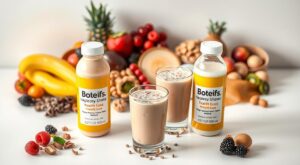Ever thought about how your daily food picks affect your blood sugar? In 2025, having a good type 2 diabetes diet plan is key to managing diabetes. Knowing what to eat and what to avoid is essential for good health. This article will show you how to make smart food choices for better blood sugar and health.
Understanding Type 2 Diabetes and Nutrition
Type 2 diabetes changes how your body handles blood sugar, or glucose. It’s important to know how nutrition helps manage this. Eating right can keep blood sugar levels stable and improve your health.
Your diet should include foods with a low glycemic index to control blood sugar. Foods high in fiber, lean proteins, and healthy fats are key. They make meal planning easier and more effective.
It’s wise to talk to healthcare providers about your diet. They can give you personalized advice and make changes as needed. Knowing how different foods affect you helps you make better choices.
Understanding type 2 diabetes and nutrition is key to better health. Choosing the right foods not only manages your condition but also improves your life quality.
Importance of a Type 2 Diabetes Diet Plan
Diet is key in managing Type 2 diabetes. A good diet helps control blood sugar levels. This is vital to avoid diabetes-related problems. By eating healthily, you boost your health and set up a lasting wellness plan.
Your food choices affect diabetes care a lot. A balanced diet helps manage weight, lowering heart disease risk. Eating more whole foods and less processed or sugary ones is smart. This healthy eating builds a better life and gives you control.
A good diet keeps blood sugar stable, preventing swings that cause tiredness and moodiness. Eating right improves your mood and energy. It makes living with diabetes easier and more fun.
In the end, healthy eating for diabetes opens doors to a better life. It improves your quality of life and lets you reach your goals, despite diabetes.
Key Elements of a Healthy Eating Plan for Diabetes
Creating a healthy eating plan for diabetes is key to managing your condition. Focus on foods that are full of nutrients but low in calories. Choose foods that are rich in vitamins and minerals but not too high in sugars or unhealthy fats.
It’s important to have balanced macronutrients in your diet. Include carbs, proteins, and fats in your meals. Carbs from whole grains, legumes, and veggies give you energy slowly. Proteins from lean meats, fish, and dairy are good, as are healthy fats from nuts and avocados for heart health.
Regular meal times help keep your blood sugar stable. Eating at the same times every day prevents big changes in your blood sugar. Also, knowing your portion sizes helps control calories and keeps your weight healthy, which is good for diabetes.
Lastly, mix up your foods to keep meals interesting and nutritious. Add different fruits, veggies, proteins, and grains to your meals. By following these tips, you can improve your health and enjoy a better life.
Recommended Foods for Blood Sugar Control
Choosing the right foods can greatly help manage blood sugar. Focus on high-quality fruits, vegetables, and whole grains. These foods are good for your health. Here are some picks for people with diabetes.
Fruits to Include in Your Diet
For fruits, pick those with a low glycemic index. Good choices include:
- Berries such as strawberries, blueberries, and raspberries
- Cherries, which also provide antioxidants
- Apples, high in fiber and vitamin C
- Oranges, giving hydration and essential nutrients
Vegetables that Are Beneficial
Choose non-starchy vegetables for diabetes. They are full of nutrients and help keep blood sugar stable:
- Leafy greens like spinach and kale
- Cruciferous vegetables such as broccoli and cauliflower
- Colorful options like bell peppers and carrots
- Zucchini, versatile in cooking
Whole Grains for Better Nutrition
Whole grains are great for diabetes. They give you energy and help control blood sugar. Try these in your meals:
- Quinoa, a complete protein
- Brown rice, more fiber than white rice
- Oats, good for your heart
- Barley, supports digestive health
By choosing these foods, you can make a diet that helps manage diabetes. It’s balanced and healthy.
Healthy Carbohydrates and Their Impact
Knowing how healthy carbs affect diabetes is key to controlling blood sugar. There are two main types of carbs: simple and complex. Simple carbs, found in sweets, cause blood sugar to rise quickly. Complex carbs, like those in whole grains, are better because they have fiber.
Foods high in fiber digest slowly, which helps blood sugar rise more gradually. This is important for keeping blood sugar stable. Whole grains, legumes, and veggies are good sources of complex carbs. They also provide important nutrients and antioxidants for health.
It’s important to watch your carb portions. Using measuring cups or a food scale can help. Choose quality over quantity with healthy carbs for diabetes. Eating whole, unprocessed foods with protein and healthy fats helps regulate blood sugar.
Diabetic-Friendly Recipes You Can Try
Eating well is key for managing Type 2 diabetes. Finding easy, tasty meals can really help. There are many diabetic-friendly recipes out there. They use healthy ingredients and are simple to make.
Here are some engaging options to consider:
- Quinoa Salad with Roasted Vegetables: This dish combines protein-rich quinoa with fresh veggies, all seasoned with lemon.
- Grilled Chicken with Spinach and Avocado: A protein-rich meal with grilled chicken, spinach, and avocado.
- Stuffed Bell Peppers: Bell peppers filled with lean turkey, brown rice, and spices for a nutritious meal.
These recipes are great for managing diabetes because they focus on whole foods and avoid added sugars. Here’s a table showing the ingredients and their health benefits:
| Ingredient | Nutritional Benefit |
|---|---|
| Quinoa | Rich in protein and fiber, which helps control blood sugar. |
| Spinach | Full of vitamins and minerals, low in calories. |
| Avocado | Provides healthy fats that may improve heart health. |
| Bell Peppers | High in antioxidants and vitamins A and C. |

Adding these recipes to your meals can make eating more enjoyable and support your health. Try different flavors and ingredients to keep your meals exciting.
The Role of Protein in Managing Diabetes
Protein is key in managing diabetes. It helps keep blood sugar levels stable and makes you feel full. Eating enough protein in your meals stops blood sugar from rising too high.
Good sources of protein for diabetes include lean meats, fish, legumes, and plant-based foods. These foods are not only nutritious but also help control insulin levels. This makes it easier to manage your diabetes. Adding different protein sources to your meals can make them more interesting and healthy.
When planning your diet, consider the following sources of protein:
| Protein Source | Benefits |
|---|---|
| Lean Meats (Chicken, Turkey) | Low in saturated fat, high in protein |
| Fish (Salmon, Tuna) | Rich in omega-3 fatty acids, supports heart health |
| Legumes (Beans, Lentils) | High in fiber, beneficial for weight management |
| Plant-Based Protein (Tofu, Tempeh) | Low cholesterol, versatile for various meals |
Adding protein to your meals can greatly help with blood sugar control. By choosing the right proteins, you can make your diet better and manage diabetes more effectively.
Understanding Fats: Good vs. Bad
Managing diabetes means knowing about fats. You’ve probably heard about good and bad fats. But what’s the difference? Knowing this can help control your health and blood sugar.
Let’s explore good fats and which ones to avoid.
Sources of Good Fats
Good fats include monounsaturated and polyunsaturated fats. They’re good for your heart and blood sugar. Here are some great sources:
- Avocados
- Olive oil
- Nuts such as almonds and walnuts
- Seeds like chia and flaxseeds
- Fatty fish, such as salmon and mackerel
Fats to Limit or Avoid
Bad fats, like saturated and trans fats, are harmful. They’re found in processed and fried foods. This can hurt your blood sugar control. To stay healthy, limit:
- Processed snacks and baked goods
- Fried foods
- Fatty cuts of red meat
- Full-fat dairy products
By choosing good fats, you support your health. Avoid bad fats to stay on track.
Meal Planning for Diabetic Patients
Effective meal planning is key for managing diabetes. The diabetes plate method makes it easier to see the right food amounts. It suggests filling half your plate with veggies, a quarter with lean protein, and a quarter with carbs.
Using the Diabetes Plate Method
The diabetes plate method is a simple guide for balanced meals. It helps manage carbs without counting. Eating more veggies like spinach and broccoli helps keep blood sugar in check.
Pairing lean proteins with whole grains makes meals nutritious and filling.
Portion Control for Better Management
Knowing portion sizes is vital for diabetes meal planning. A portion is the food you eat at once. Learning the right sizes helps avoid overeating, which is key for blood sugar control.
Use your hand as a guide: meat should be the size of your palm, and fruit the size of your fist. Choosing whole foods over processed ones leads to healthier choices. For more on portion sizes, visit this resource.

Low Glycemic Eating Plan Explained
A low glycemic eating plan focuses on foods that don’t raise blood sugar much. These foods digest slowly, keeping energy levels steady all day. The glycemic index (GI) rates carbs from 0 to 100, showing how fast they raise blood sugar. Foods with a GI of 55 or less are best for those with diabetes.
Adding low glycemic foods to your diet boosts nutrition. Choose whole grains, legumes, fruits, and non-starchy veggies. For instance, oats, quinoa, and lentils are great for nutrients without blood sugar spikes. A low glycemic diet lets you enjoy a variety of meals while improving health.
To help pick low glycemic foods, here’s a handy chart:
| Food | Glycemic Index (GI) |
|---|---|
| Oats | 55 |
| Quinoa | 53 |
| Brown Rice | 50 |
| Chickpeas | 28 |
| Apples | 36 |
| Carrots | 41 |
Following a low glycemic diet helps keep blood sugar stable. It can also cut hunger and support a lower weight. Making smart food choices leads to lasting health benefits. By mixing up low glycemic foods, you stay full and manage blood sugar better.
Creating a Daily Meal Schedule
Creating a daily meal schedule for diabetes is key for managing blood sugar. Eating at regular times helps keep glucose levels steady. This prevents the spikes that come with eating at random times. A consistent meal plan can also boost your health and energy.
When planning your meals, space them out throughout the day. This method helps control blood sugar and keeps you feeling full and energetic. Here are some tips for the best timing meals for diabetes:
- Start your day with a balanced breakfast within an hour of waking up.
- Plan snacks between meals to avoid long gaps of time without food.
- Incorporate a variety of foods at each meal to ensure a balanced diet.
- Aim for regular dinner times, preferably at least 2-3 hours before bedtime.
Following a structured meal schedule has many benefits. Eating at the same times each day helps your body adjust. This leads to better insulin response and digestion. Your body also uses nutrients more efficiently throughout the day.
Here’s a sample daily meal schedule to show you how to time your meals:
| Time | Meal | Examples |
|---|---|---|
| 7:00 AM | Breakfast | Oatmeal with berries and a sprinkle of nuts |
| 10:00 AM | Snack | Greek yogurt with a small portion of fruit |
| 12:30 PM | Lunch | Grilled chicken salad with a variety of vegetables |
| 3:00 PM | Snack | Carrot sticks with hummus |
| 6:00 PM | Dinner | Baked salmon, quinoa, and steamed broccoli |
| 8:00 PM | Snack (Optional) | Small apple or a handful of almonds |
This schedule is just a starting point. Feel free to make changes to fit your needs and lifestyle. Sticking to a timing meals for diabetes plan can greatly improve your health and well-being.
Managing Snacks: What to Choose and What to Avoid
Snacking is important for managing diabetes. Choosing healthy snacks helps keep blood sugar stable and controls hunger. Look for snacks high in protein and fiber. These nutrients make you feel full and support good nutrition.
Good snack choices include Greek yogurt, hummus with veggies, or almonds. These snacks offer the right mix of nutrients and help with diabetes management. Whole-grain crackers with turkey or avocado are also great options.

Stay away from processed and sugary snacks, as they can raise blood sugar. Candy bars, sugary granola bars, and chips might taste good but aren’t good for you. Opt for snacks with protein, healthy fats, and complex carbs for steady energy.
Preparing snacks in advance is essential for diabetes management. Making your own snacks means you have healthy options always available. Try portioning nuts or cutting up fresh fruit for easy, healthy snacks.
By picking the right snacks, you can enjoy tasty treats while managing your diabetes well. This helps keep your blood sugar levels healthy.
Hydration: Importance of Choosing the Right Beverages
Staying hydrated is key for good health, even more so for those with diabetes. Drinking enough water helps keep blood sugar levels in check. It also helps your body work better. Water is the best choice because it has no sugar or calories.
Unsweetened tea and black coffee are also good for diabetes. They have few calories and are full of antioxidants. Adding these to your day can help you stay hydrated without too much sugar.
But, some drinks are not good for you. Drinks like sodas and fruit juices can raise your blood sugar too high. Also, drinks with lots of calories, like fancy coffees and energy drinks, are not good. Look for drinks that help you stay hydrated without harming your health.
For a detailed meal plan, check out this meal plan for prediabetes reversal. It includes drinks that help with hydration. Making the right drink choices can really help manage your diabetes.
In short, choosing the right drinks is very important for diabetes management. Stick to drinks that support your health goals and avoid sugary, high-calorie ones. Your drink choices can greatly impact your health.
Monitoring Blood Sugar Levels Effectively
Managing diabetes means keeping an eye on your blood sugar levels. It’s key to stay on top of your diabetes blood glucose management. Regular checks help you make better choices about what you eat and how you live.
A good glucose meter makes tracking easy. Knowing your target ranges is important for your health. Testing at various times shows how different activities affect your levels.
Keeping a record of your results is very helpful. It helps you see patterns and make needed changes. This also keeps you focused on managing your diabetes well.
Diet Tips for Type 2 Diabetes Success
Living with Type 2 diabetes means you need to be active about what you eat. Using good diet tips can help you keep your blood sugar in check. Make sure your meals have a variety of foods, rich in nutrients, and watch your carb intake.
- Keep a food journal to track what you eat, helping you to identify patterns and problem areas.
- Experiment with new recipes that align with a successful diabetes diet. Consider trying quinoa salads or stir-fried vegetables with lean proteins.
- Read nutrition labels meticulously. Understanding the carbohydrate content, serving sizes, and nutritional information is key.
- Include fiber-rich foods like whole grains, legumes, and vegetables, which can improve your digestion and stabilize blood sugar.
- Plan your meals ahead of time. This strategy helps in avoiding impulsive and unhealthy choices.
Every small change can make a big difference in managing diabetes. Start using these simple yet effective diet tips to create a plan that fits your needs.

Common Mistakes to Avoid When Following a Diet Plan
Starting a diabetes diet plan can be tough. It’s important to avoid common diet mistakes to manage diabetes well. Paying attention to portion sizes is key. Eating too much, even healthy foods, can cause weight gain and affect blood sugar.
Tracking what you eat is also helpful. It keeps your blood sugar in check.
Another mistake is skipping meals. This can cause big changes in blood sugar levels. It makes managing diabetes hard. Eating regular meals helps keep your metabolism steady and reduces cravings.
Not knowing about hidden sugars in foods is a big problem. Many processed foods have added sugars that can raise blood sugar levels suddenly. Always check food labels to know the sugar content.
To show some common diet mistakes, here’s a table with key pitfalls and their effects:
| Mistake | Effect on Diabetes Management |
|---|---|
| Ignoring Portion Sizes | Leads to overeating, raising blood sugar levels |
| Skipping Meals | Causes blood sugar fluctuations, increases hunger |
| Overlooking Hidden Sugars | Contributes to unexpected sugar spikes |
| Lack of Planning | Results in unhealthy food choices on the go |
Knowing these common diet mistakes can improve your diabetes management. By fixing these issues, you can make better food choices and reach your health goals.
Staying Motivated: Maintaining Healthy Eating Habits
Keeping up motivation for healthy eating is key when you’re on a Type 2 diabetes diet. Setting goals that feel achievable helps you stay on track. Break down big goals into smaller ones. Celebrate every small win, like trying a new recipe or picking a healthy snack.
Getting support from doctors or groups can really help on hard days. Talking to others with similar goals creates a supportive space. Their stories can inspire you to keep going, even when it’s tough.
Dealing with cravings and setbacks is part of the journey. If cravings strike, try drinking water or having a small healthy snack. Remember, everyone has setbacks. Learn from them and keep moving forward.
Keeping healthy habits takes effort, but every step is a positive one. Stay focused, use support, and have strategies for tough times. This way, you can keep up your healthy eating habits for a long time.
Conclusion
Creating a good type 2 diabetes diet plan is key to managing your blood sugar. Choose foods like whole grains, lean proteins, and healthy fats for better health. Planning your meals is vital to keep your diet balanced and consistent.
Every small change counts on this journey. Stay motivated to make a meal plan that fits your life. Understanding the key points in this article will help you make better choices for your health.
By focusing on your diet, you can manage your blood sugar better and live a healthier life. Start today and see the positive changes in your well-being.













